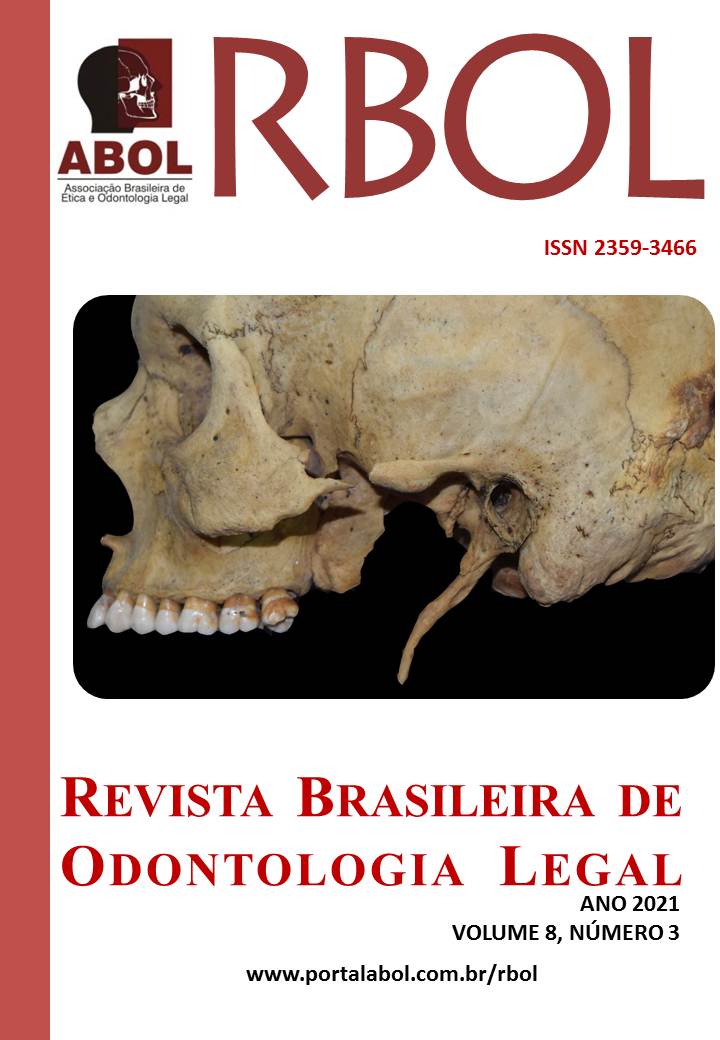POSTMORTEM CROSS-SECTIONAL SLICING OF THE FRONTAL SINUSES AND COMPARISON WITH ANTEMORTEM ANATOMICAL IMAGES – A CASE REPORT
DOI:
https://doi.org/10.21117/rbol-v8n32021-402Palavras-chave:
Anatomia, Odontologia Legal, Medicina Legal, Seio frontal, Identificação humanaResumo
The anatomical features of the frontal sinuses (FS) are known as highly distinctive and potentially useful for human identification. Assessing these structures with advanced postmortem (PM) imaging, however, is not always feasible in medicolegal units worldwide. This study proposes and validates the anatomical assessment of the FS via cross-sectional slicing of the frontal bone to reproduce images comparable to antemortem (AM) axial views. The bodies of two unknown sisters with advanced decay (decomposition stage III.1) were referred for human identification. The AM data provided for comparative analysis consisted of multi-slice computed tomography (CT) and magnetic resonance images of the skull. In the lack of primary alternatives for human identification, PM assessment of the FS was considered. Justified by the mortuary facilities there were not equipped with CT devices, sequential cross-sectional slicing of the frontal bone was performed. With the skulls in supine position, the technique followed Griesinger’s anteroposterior plane using an oscillating saw blade at 90⁰. Multiple slices (n = 20) of the frontal bone were obtained in craniocaudal direction up to the superior limit of the orbits. The outline of the FS, as well the number of lobes and position of the intersinus septum were visible and compatible with the AM data, enabling positive identification. External validation of the proposed technique was accomplished by reproducing it to successfully identify a male victim in a medicolegal institute 2,000 KM far from the original site.
Downloads
Publicado
Edição
Seção
Licença
Os autores deverão encaminhar por email, devidamente assinada pelos autores ou pelo autor responsável pelo trabalho, a declaração de responsabilidade e transferência de direitos autorais para a RBOL, conforme modelo abaixo.
DECLARAÇÃO DE RESPONSABILIDADE E TRANSFERÊNCIA DE DIREITOS AUTORAIS
Eu (Nós), listar os nomes completos dos autores, transfiro(rimos) todos os direitos autorais do artigo intitulado: colocar o título à Revista Brasileira de Odontologia Legal - RBOL.
Declaro(amos) que o trabalho mencionado é original, não é resultante de plágio, que não foi publicado e não está sendo considerado para publicação em outra revista, quer seja no formato impresso ou no eletrônico.
Declaro(amos) que o presente trabalho não apresenta conflitos de interesse pessoais, empresariais ou governamentais que poderiam comprometer a obtenção e divulgação dos resultados bem como a discussão e conclusão do estudo.
Declaro(amos) que o presente trabalho foi totalmente custeado por seus autores. Em caso de financiamento, identificar qual a empresa, governo ou agência financiadora.
Local, data, mês e ano.
Nome e assinatura do autor responsável (ou de todos os autores).

